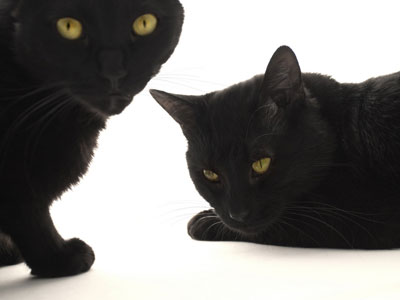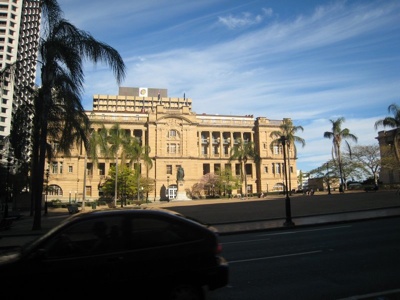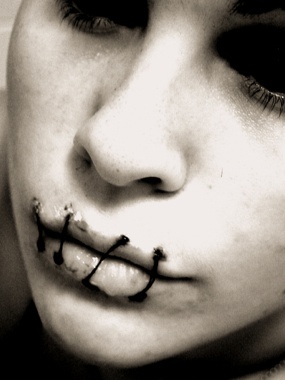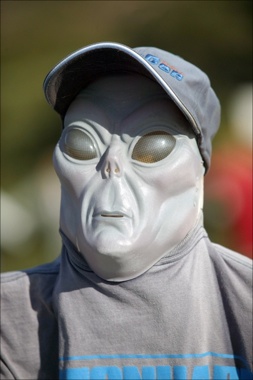Thursday, July 30, 2009
Sekhmet, Powerful One, Sun Goddess, Destructor
"The good god, the lord of action, Neb-Ma'at-Ra [Amenhotep III], Beloved of Sekhmet, the Mistress of Dread, who gives life eternally. The son of the God Ra of His own body, Amenhotep, ruler of Thebes, Beloved of Sekhmet, the Mistress of Dread, Who gives life eternally."
-- Inscription on a statue of Sekhmet
The lion-headed goddess Sekhmet (Sakhmet, Sekhet) was a member of the Memphite Triad, thought to be the wife of Ptah and mother of Nefertem (though the motherhood of Nefertem was in dispute - Bast and Wadjet were touted as his mother in their respective cities). Associated with war and retribution, she was said to use arrows to pierce her enemies with fire, her breath being the hot desert wind as her body took on the glare of the midday sun. She represented the destructive force of the sun.
According to the legends, she came into being when Hathor was sent to earth by Ra to take vengeance on man. She was the one who slaughtered mankind and drank their blood, only being stopped by trickery (this story can be found under Hathor's story). She was, thus, the destructive side of the sun, and a solar goddess and given the title Eye of Ra.
Being mother of Nefertem, who himself was a healing god, gives her a more protective side that manifested itself in her aspect of goddess of healing and surgery. Part of her destruction side was also disease and plague, as the 'Lady of Pestilence'... but she could also cure said ailments. The priests of Sekhmet were specialists in the field of medicine, arts linked to ritual and magic. They were also trained surgeons of remarkable caliber. Pharaoh Amenhotep III had many statues of Sekhmet, and it has been theorized that this was because he dental and health problems that he hoped the goddess may cure.
Hundreds of Amenhotep's Sekhmet statues were found in the Theban temple precinct of the goddess Mut at South Karnak. The statues may have been made for the king's funerary temple on the West Bank of the Nile and may have been dispersed to other sites at Thebes and elsewhere beginning with the reign of Ramesses II.
Sekhmet was depicted as a lion-headed woman with the sun disk and uraeus serpent headdress. Although she is connected with Bast, she has no relationship with the cat goddess. They are two distinct goddesses in their own rights - the Egyptians did not claim they were siblings of any kind. Bast and Sekhmet were an example of Egyptian duality - Sekhmet was a goddess of Upper Egypt, Bast of Lower Egypt (just like the pharaoh was of Upper and/or Lower Egypt!)... and they were linked together by geography, not by myth or legend.
Sekhmet was mentioned a number of times in the spells of the Book of the Dead:
The Chapter of Driving Back the Slaughters Which are Performed in Hensu
My belly and back are the belly and back of Sekhmet. My buttocks are the buttocks of the Eye of Horus.
The Chapter of Giving a Heart to the Osiris
May the goddess Sekhmet raise me, and lift me up. Let me ascend into heaven, let that which I command be performed in Het-ka-Ptah. I know how to use my heart. I am master of my heart-case. I am master of my hands and arms. I am master of my legs. I have the power to do that which my KA desireth to do. My Heart-soul shall not be kept a prisoner in my body at the gates of Amentet when I would go in in peace and come forth in peace.
The Osiris Whose Word is Truth
I have made supplication to the Khati gods and to Sekhmet in the temple of Net (Neith), or the Aged Ones ... I have approached with worship the two Khati gods and Sekhmet, who are in the temple of the Aged One [in Anu].
The Chapter of Opening the Mouth
I am the goddess Sekhmet, and I take my seat upon the place by the side of Amt-ur the great wind of heaven.
Her cult center was in Memphis, but during the New Kingdom when the seat of power shifted to Thebes, Sekhmet's powers were absorbed by Mut. Sekhmet was soon represented as Mut's aggressive side, rather than a goddess in her own right.
Thursday, July 16, 2009
Top 10 Strange Phenomena of the Mind
The mind is a wonderful thing – there is so much about it which remains a mystery to this day. Science is able to describe strange phenomena, but can not account for their origins. While most of us are familiar with one or two on this list, many others are mostly unknown outside of the psychological realm. This is a list of the top ten strange mental phenomena.
We have all some experience of a feeling, that comes over us occasionally, of what we are saying and doing having been said and done before, in a remote time – of our having been surrounded, dim ages ago, by the same faces, objects, and circumstances –of our knowing perfectly what will be said next, as if we suddenly remember it!
– Charles Dickens
10. Déjà Vu
 Déjà vu is the experience of being certain that you have experienced or seen a new situation previously – you feel as though the event has already happened or is repeating itself. The experience is usually accompanied by a strong sense of familiarity and a sense of eeriness, strangeness, or weirdness. The “previous” experience is usually attributed to a dream, but sometimes there is a firm sense that it has truly occurred in the past.
Déjà vu is the experience of being certain that you have experienced or seen a new situation previously – you feel as though the event has already happened or is repeating itself. The experience is usually accompanied by a strong sense of familiarity and a sense of eeriness, strangeness, or weirdness. The “previous” experience is usually attributed to a dream, but sometimes there is a firm sense that it has truly occurred in the past.
We have all some experience of a feeling, that comes over us occasionally, of what we are saying and doing having been said and done before, in a remote time – of our having been surrounded, dim ages ago, by the same faces, objects, and circumstances –of our knowing perfectly what will be said next, as if we suddenly remember it!
– Charles Dickens
10. Déjà Vu
 Déjà vu is the experience of being certain that you have experienced or seen a new situation previously – you feel as though the event has already happened or is repeating itself. The experience is usually accompanied by a strong sense of familiarity and a sense of eeriness, strangeness, or weirdness. The “previous” experience is usually attributed to a dream, but sometimes there is a firm sense that it has truly occurred in the past.
Déjà vu is the experience of being certain that you have experienced or seen a new situation previously – you feel as though the event has already happened or is repeating itself. The experience is usually accompanied by a strong sense of familiarity and a sense of eeriness, strangeness, or weirdness. The “previous” experience is usually attributed to a dream, but sometimes there is a firm sense that it has truly occurred in the past.9. Déjà Vécu

Déjà vécu (pronounced vay-koo) is what most people are experiencing when they think they are experiencing deja vu. Déjà vu is the sense of having seen something before, whereas déjà vécu is the experience of having seen an event before, but in great detail – such as recognizing smells and sounds. This is also usually accompanied by a very strong feeling of knowing what is going to come next. In my own experience of this, I have not only known what was going to come next, but have been able to tell those around me what is going to come next – and I am right. This is a very eerie and unexplainable sensation.

Déjà vécu (pronounced vay-koo) is what most people are experiencing when they think they are experiencing deja vu. Déjà vu is the sense of having seen something before, whereas déjà vécu is the experience of having seen an event before, but in great detail – such as recognizing smells and sounds. This is also usually accompanied by a very strong feeling of knowing what is going to come next. In my own experience of this, I have not only known what was going to come next, but have been able to tell those around me what is going to come next – and I am right. This is a very eerie and unexplainable sensation.
8. Déjà Visité

Déjà visité is a less common experience and it involves an uncanny knowledge of a new place. For example, you may know your way around a a new town or a landscape despite having never been there, and knowing that it is impossible for you to have this knowledge. Déjà visité is about spatial and geographical relationships, while déjà vécu is about temporal occurrences. Nathaniel Hawthorne wrote about an experience of this in his book “Our Old Home” in which he visited a ruined castle and had a full knowledge of its layout. He was later able to trace the experience to a poem he had read many years early by Alexander Pope in which the castle was accurately described.
7. Déjà Senti

Déjà senti is the phenomenon of having “already felt” something. This is exclusively a mental phenomenon and seldom remains in your memory afterwards. In the words of a person having experienced it: “What is occupying the attention is what has occupied it before, and indeed has been familiar, but has been forgotten for a time, and now is recovered with a slight sense of satisfaction as if it had been sought for. The recollection is always started by another person’s voice, or by my own verbalized thought, or by what I am reading and mentally verbalize; and I think that during the abnormal state I generally verbalize some such phrase of simple recognition as ‘Oh yes—I see’, ‘Of course—I remember’, etc., but a minute or two later I can recollect neither the words nor the verbalized thought which gave rise to the recollection. I only find strongly that they resemble what I have felt before under similar abnormal conditions.”
You could think of it as the feeling of having just spoken, but realizing that you, in fact, didn’t utter a word.
6. Jamais Vu

Jamais vu (never seen) describes a familiar situation which is not recognized. It is often considered to be the opposite of déjà vu and it involves a sense of eeriness. The observer does not recognize the situation despite knowing rationally that they have been there before. It is commonly explained as when a person momentarily doesn’t recognize a person, word, or place that they know. Chris Moulin, of Leeds University, asked 92 volunteers to write out “door” 30 times in 60 seconds. He reported that 68 per cent of his guinea pigs showed symptoms of jamais vu, such as beginning to doubt that “door” was a real word. This has lead him to believe that jamais vu may be a symptom of brain fatigue.
5. Presque Vu

Presque vu is very similar to the “tip of the tongue” sensation – it is the strong feeling that you are about to experience an epiphany – though the epiphany seldom comes. The term “presque vu” means “almost seen”. The sensation of presque vu can be very disorienting and distracting.

Déjà visité is a less common experience and it involves an uncanny knowledge of a new place. For example, you may know your way around a a new town or a landscape despite having never been there, and knowing that it is impossible for you to have this knowledge. Déjà visité is about spatial and geographical relationships, while déjà vécu is about temporal occurrences. Nathaniel Hawthorne wrote about an experience of this in his book “Our Old Home” in which he visited a ruined castle and had a full knowledge of its layout. He was later able to trace the experience to a poem he had read many years early by Alexander Pope in which the castle was accurately described.
7. Déjà Senti

Déjà senti is the phenomenon of having “already felt” something. This is exclusively a mental phenomenon and seldom remains in your memory afterwards. In the words of a person having experienced it: “What is occupying the attention is what has occupied it before, and indeed has been familiar, but has been forgotten for a time, and now is recovered with a slight sense of satisfaction as if it had been sought for. The recollection is always started by another person’s voice, or by my own verbalized thought, or by what I am reading and mentally verbalize; and I think that during the abnormal state I generally verbalize some such phrase of simple recognition as ‘Oh yes—I see’, ‘Of course—I remember’, etc., but a minute or two later I can recollect neither the words nor the verbalized thought which gave rise to the recollection. I only find strongly that they resemble what I have felt before under similar abnormal conditions.”
You could think of it as the feeling of having just spoken, but realizing that you, in fact, didn’t utter a word.
6. Jamais Vu

Jamais vu (never seen) describes a familiar situation which is not recognized. It is often considered to be the opposite of déjà vu and it involves a sense of eeriness. The observer does not recognize the situation despite knowing rationally that they have been there before. It is commonly explained as when a person momentarily doesn’t recognize a person, word, or place that they know. Chris Moulin, of Leeds University, asked 92 volunteers to write out “door” 30 times in 60 seconds. He reported that 68 per cent of his guinea pigs showed symptoms of jamais vu, such as beginning to doubt that “door” was a real word. This has lead him to believe that jamais vu may be a symptom of brain fatigue.
5. Presque Vu

Presque vu is very similar to the “tip of the tongue” sensation – it is the strong feeling that you are about to experience an epiphany – though the epiphany seldom comes. The term “presque vu” means “almost seen”. The sensation of presque vu can be very disorienting and distracting.
4. L’esprit de l’Escalier

L’esprit de l’escalier (stairway wit) is the sense of thinking of a clever comeback when it is too late. The phrase can be used to describe a riposte to an insult, or any witty, clever remark that comes to mind too late to be useful—when one is on the “staircase” leaving the scene. The German word treppenwitz is used to express the same idea. The closest phrase in English to describe this situation is “being wise after the event”. The phenomenon is usually accompanied by a feeling of regret at having not thought of the riposte when it was most needed or suitable.

L’esprit de l’escalier (stairway wit) is the sense of thinking of a clever comeback when it is too late. The phrase can be used to describe a riposte to an insult, or any witty, clever remark that comes to mind too late to be useful—when one is on the “staircase” leaving the scene. The German word treppenwitz is used to express the same idea. The closest phrase in English to describe this situation is “being wise after the event”. The phenomenon is usually accompanied by a feeling of regret at having not thought of the riposte when it was most needed or suitable.
3. Capgras Delusion

Capgras delusion is the phenomenon in which a person believes that a close friend or family member has been replaced by an identical looking impostor. This could be tied in to the old belief that babies were stolen and replaced by changelings in medieval folklore, as well as the modern idea of aliens taking over the bodies of people on earth to live amongst us for reasons unknown. This delusion is most common in people with schizophrenia but it can occur in other disorders.

Capgras delusion is the phenomenon in which a person believes that a close friend or family member has been replaced by an identical looking impostor. This could be tied in to the old belief that babies were stolen and replaced by changelings in medieval folklore, as well as the modern idea of aliens taking over the bodies of people on earth to live amongst us for reasons unknown. This delusion is most common in people with schizophrenia but it can occur in other disorders.
2. Fregoli Delusion

Fregoli delusion is a rare brain phenomenon in which a person holds the belief that different people are, in fact, the same person in a variety of disguises. It is often associated with paranoia and the belief that the person in disguise is trying to persecute them. The condition is named after the Italian actor Leopoldo Fregoli who was renowned for his ability to make quick changes of appearance during his stage act. It was first reported in 1927 in the case study of a 27-year-old woman who believed she was being persecuted by two actors whom she often went to see at the theatre. She believed that these people “pursued her closely, taking the form of people she knows or meets”.
1. Prosopagnosia

Prosopagnosia is a phenomenon in which a person is unable to recognize faces of people or objects that they should know. People experiencing this disorder are usually able to use their other senses to recognize people – such as a person’s perfume, the shape or style of their hair, the sound of their voice, or even their gait. A classic case of this disorder was presented in the 1998 book (and later Opera by Michael Nyman) called “The man who mistook his wife for a hat”.

Fregoli delusion is a rare brain phenomenon in which a person holds the belief that different people are, in fact, the same person in a variety of disguises. It is often associated with paranoia and the belief that the person in disguise is trying to persecute them. The condition is named after the Italian actor Leopoldo Fregoli who was renowned for his ability to make quick changes of appearance during his stage act. It was first reported in 1927 in the case study of a 27-year-old woman who believed she was being persecuted by two actors whom she often went to see at the theatre. She believed that these people “pursued her closely, taking the form of people she knows or meets”.
1. Prosopagnosia

Prosopagnosia is a phenomenon in which a person is unable to recognize faces of people or objects that they should know. People experiencing this disorder are usually able to use their other senses to recognize people – such as a person’s perfume, the shape or style of their hair, the sound of their voice, or even their gait. A classic case of this disorder was presented in the 1998 book (and later Opera by Michael Nyman) called “The man who mistook his wife for a hat”.
CHAKRA ENERGY: Ways to Energize Your Chakras

Thoughts
Thought is an energy form. Science has proven a positive thought allows our energy to flow freely and unrestricted. Whereas, negative thoughts decrease energy within our body. Every thought (whether mental or emotional) is connected to a chakra. For example, a passionate thought is a red energy stimulant, but an angry thought decreases one's positive red energy flow. This means that continual angry thoughts will lower your root chakra's energy.
--------------------------------------------------------------------------------
The Sun
This is our most important energy source. Through light all the seven color energies flow from the sun’s rays to the earth. People, animals, plants, minerals, water and our chakras receive energy from the sun’s light. (If you are not able to enjoy the sun for a few hours daily, add a quality full spectrum light bulb to a light source in your work area or in a lamp at home.)
--------------------------------------------------------------------------------
Food
When the sun’s rays bless all plant life, it gives the plant life/energy. Once the plant absorbs energy, the color energy that remains is the energy of that fruit, vegetable or flower. Without this energy our body could not assimilate the nutritional value of the food. Balance your chakras daily by eating foods that contain each of the seven color energies (that’s why the doctor always said to eat a plate of different colored foods... for the color value!).
--------------------------------------------------------------------------------
Visualization
Meditation & Breathing (Yoga). Since thought is an energy form you can stimulate your chakra centers through meditation, visualization or breathing energy into your various chakra centers. By adding the color intention adds additional power from a chakra’s vibration.
--------------------------------------------------------------------------------
Gems/Minerals
Gemstones and minerals are also energy forms. For example, crystals contain a similar crystalline structure as the human body. Crystals amplify energy and can be programmed (e.g. computer chips and watches). Wearing gemstone jewelry or placing gemstones and minerals in your environment is a simple way to absorb the stone or mineral’s healing vibrations.
--------------------------------------------------------------------------------
Color Bathing
(One of my favorites!) Water is a conductor of energy and color is an energy. While lying in the colored water your body absorbs the vibrational frequency from the color. Take the time to give back to your body and soul! While bathing, balance that chakra by thinking about what you would like to achieve from that specific energy and maybe add the correlating aromatherapy oil. Do not use chemical food coloring to dye your water. I recommend Colour Bath™ by Colour Energy Corporation, as it is totally organic and therefore safe to use.
--------------------------------------------------------------------------------
Aromatherapy
Essential oils are the pure essence of the plant or flower. Every oil has a vibration that correlates to a color. Oils contain the healing properties of herbs, flowers or plants. Use only therapeutic quality oils (inexpensive oils may contain toxins). Also never apply oils directly on your skin (dilute with a carrier oil or in a bath).
--------------------------------------------------------------------------------
Music & Dance
Music effects us in a positive or negative way. Every musical note corresponds to a color and chakra center. Certain sounds can stimulate an emotional, mental, physical or spiritual response. E.g. Listening or dancing to primal music, such as the beating of drums, can energize your physical body and stimulate your root chakra.
--------------------------------------------------------------------------------
Toning & Sounds
We can vocally make sounds to vibrate at the same frequency as various organs in our body. Regular toning can help keep our body’s organs functioning properly. Noise pollution can be very disturbing to our environment. Surround yourself with sounds, which make you happy and productive!
--------------------------------------------------------------------------------
Color Tonations
By shining of light through various color filters directly onto the body, the vibration of the color will be absorbed through your skin effecting the designated area.
--------------------------------------------------------------------------------
Solarized Water
Charge water by filling a colored glass with water or by placing a colored filter in front of a glass of water and let the sun’s rays kiss the water with color energy. Make sure the glass is not leaded and of a clean color hue.
--------------------------------------------------------------------------------
Syntonics
Is the use of color through the eyes. Via our eyes color stimulates our pituitary gland, which in turn releases hormones connected to the correlating organ of the same frequency. Therapeutic eye glasses that are manufactured with various colored filters can be simply worn whenever you need a boost of a certain color or chakra energy. Make sure the color eyeglasses are 100% UVA & UVB coated if wearing outdoors and again the exact color tint of the lens is very, very important. Note: Unless the color glass manufacturer or distributor is aware of color therapy, chances are their colored lenses are not made for healing purposes.
--------------------------------------------------------------------------------
Decor
Use colors consciously in your home or work environment to give you more positive and productive energy. Paint a room or add different colored pillows, artwork, carpets, etc.
--------------------------------------------------------------------------------
Clothing
What we wear will influence our mood, mind and energy level. Light penetrates through our clothing amplifying the color energy we are wearing. The more vibrant the clothing the better the energy transfer.
--------------------------------------------------------------------------------
Art & Color
Art and color can be used as an outlet to either express or stimulate. Surround yourself with the colors, which are suitable for what you need to accomplish in that area. Use calming colors in your bedroom and mentally stimulating colors in your workspace.
Thursday, July 9, 2009
Greek Tragedy: Euripides' Medea
I love Greek Tragedy :)
One of my favorites is Euripedes' Medea.

The story starts in a state of conflict. Jason has abandoned his wife, Medea, along with their two children. He hopes to advance his station by remarrying with Glauce, the daughter of Creon, king of Corinth, the Greek city where the play is set. All the events of play proceed out of this initial dilemma, and the involved parties become its central characters.
Outside the royal palace, a nurse laments the events that have lead to the present crisis. After a long series of trials and adventures, which ultimately forced Jason and Medea to seek exile in Corinth, the pair had settled down and established their family, achieving a degree of fame and respectability. Jason's recent abandonment of that family has crushed Medea emotionally, to the degree that she curses her own existence, as well as that of her two children.
Fearing a possible plot of revenge, Creon banishes Medea and her children from the city. After pleading for mercy, Medea is granted one day before she must leave, during which she plans to complete her quest for "justice"--at this stage in her thinking, the murder of Creon, Glauce, and Jason. Jason accuses Medea of overreacting. By voicing her grievances so publicly, she has endangered her life and that of their children. He claims that his decision to remarry was in everyone's best interest. Medea finds him spineless, and she refuses to accept his token offers of help.
Appearing by chance in Corinth, Aegeus, King of Athens, offers Medea sanctuary in his home city in exchange for her knowledge of certain drugs that can cure his sterility. Now guaranteed an eventual haven in Athens, Medea has cleared all obstacles to completing her revenge, a plan which grows to include the murder of her own children; the pain their loss will cause her does not outweigh the satisfaction she will feel in making Jason suffer.
For the balance of the play, Medea engages in a ruse; she pretends to sympathize with Jason (bringing him into her confidence) and offers his wife "gifts," a coronet and dress. Ostensibly, the gifts are meant to convince Glauce to ask her father to allow the children to stay in Corinth. The coronet and dress are actually poisoned, however, and their delivery causes Glauce's death. Seeing his daughter ravaged by the poison, Creon chooses to die by her side by dramatically embracing her and absorbing the poison himself.
A messenger recounts the gruesome details of these deaths, which Medea absorbs with cool attentiveness. Her earlier state of anxiety, which intensified as she struggled with the decision to commit infanticide, has now given way to an assured determination to fulfill her plans. Against the protests of the chorus, Medea murders her children and flees the scene in a dragon-pulled chariot provided by her grandfather, the Sun-God. Jason is left cursing his lot; his hope of advancing his station by abandoning Medea and marrying Glauce, the conflict which opened the play, has been annihilated, and everything he values has been lost through the deaths that conclude the tragedy.
Below is a link to a copy of the Euripides' Medea:) http://www.stoa.org/diotima/anthology/EuripidesMedeaLuschnig.pdf
Enjoy
- Oculus
Tuesday, July 7, 2009
Subscribe to:
Comments (Atom)
